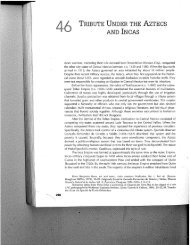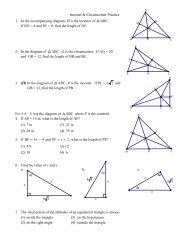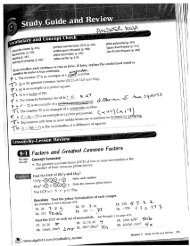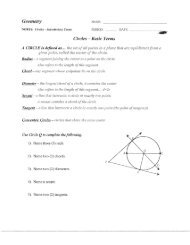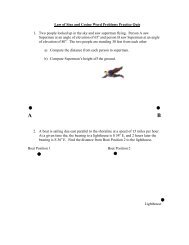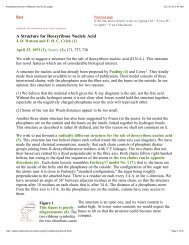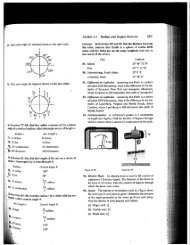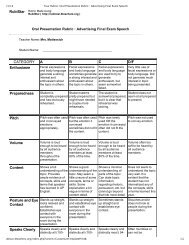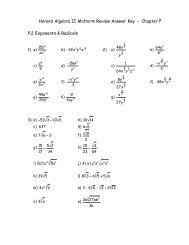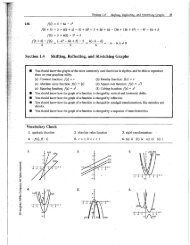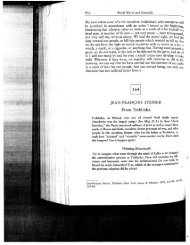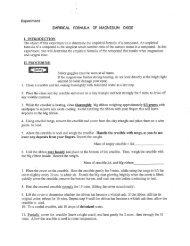Answer the following questions in your own words while thinking ...
Answer the following questions in your own words while thinking ...
Answer the following questions in your own words while thinking ...
- No tags were found...
Create successful ePaper yourself
Turn your PDF publications into a flip-book with our unique Google optimized e-Paper software.
Conclusion:<strong>Answer</strong> <strong>the</strong> <strong>follow<strong>in</strong>g</strong> <strong>questions</strong> <strong>in</strong> <strong>your</strong> <strong>own</strong> <strong>words</strong> <strong>while</strong> th<strong>in</strong>k<strong>in</strong>g about <strong>the</strong> activity you just completed. (Youdraw a picture to help expla<strong>in</strong> <strong>your</strong> answers.)i. Describe/def<strong>in</strong>e position.Describe/def<strong>in</strong>e velocity:3. What is a vector?4. How are position and velocity related?Describe how <strong>the</strong> man could have positive position <strong>while</strong> hav<strong>in</strong>g a negative velocity.6. Describe how <strong>the</strong> man could have nesative position <strong>while</strong> hav<strong>in</strong>8 a positive velocity.7. Describe how <strong>the</strong> man could have positive position <strong>while</strong> hav<strong>in</strong>~ a positive velodtT.Describe how <strong>the</strong> man could have negative position <strong>while</strong> hav<strong>in</strong>g a negative velocity.Schiller/Barton Physics, Created Fall 2011
Mov<strong>in</strong>g Man - V~locity vs. Time GraphsStudent PagesBackground - Remember graphs are not just an evil th<strong>in</strong>g <strong>your</strong> teacher makes you create, <strong>the</strong>y are a meansof communication. Graphs are a way of communicat<strong>in</strong>g by us<strong>in</strong>g pictures and s<strong>in</strong>ce a picture is worth a thousand<strong>words</strong> know<strong>in</strong>g how to make and <strong>in</strong>terpret graphs will save you a lot of writ<strong>in</strong>g. (~Learn<strong>in</strong>g Goals = The stadents will:Develop a general kqowledge of "Ve!ocity vs. Time" graphs and"Distance vs. Time":graph~o What graphs of a person stand<strong>in</strong>g stil! would look likeo What graphs of a person mov<strong>in</strong>g away from an observer ata constant speed would look like.o What graphs ofaperson mov<strong>in</strong>g towards an observer at aconstant speed would look like.~ o How differences <strong>in</strong> speed appear on <strong>the</strong> graphsProcedure - Do tile <strong>follow<strong>in</strong>g</strong> activity us<strong>in</strong>g this web sitehttp://www.colorado.edu/physics!pheVsimulations-base.htmlThen click on "The Mov<strong>in</strong>g Man"Screen 11. Gett<strong>in</strong>g started. After~"The Mov<strong>in</strong>g Man" is open leave <strong>the</strong> position graph and <strong>the</strong> velocity graphopen but close <strong>the</strong> acceleration graph. Your screen should look like screen 1.2. Mak<strong>in</strong>g observations. By ei<strong>the</strong>r click<strong>in</strong>g on <strong>the</strong> man or <strong>the</strong> slider cause <strong>the</strong> man to move back andforth and observe what shows up on <strong>the</strong> graphs. Us<strong>in</strong>g <strong>the</strong> axis provided below make sketches ofDistance vs. Time and Velocity vs. Time graphs for <strong>the</strong> actions described next to each axis.A man mov<strong>in</strong>g from 0to !0 at a slow steadypace.-i0 -I0C~)A man mov<strong>in</strong>g from 0to 10 at a fast pace.~5... (s)~-5 ~-5-10 -10(s)A man stand<strong>in</strong>g still at1o~-5-i0
velocity
Velocip! Graph PracticeAt what time(s) dur<strong>in</strong>g this graph is <strong>the</strong> vehicle stand<strong>in</strong>g still?Dur<strong>in</strong>g which time period does <strong>the</strong> vehicle experience <strong>the</strong> greatestacceleration?~5When are brakes be<strong>in</strong>g applied?Describe, <strong>the</strong> motion of this vehicle from t=0 to t=40 seconds.
Multiple Representations of MotionUltrasonic Motion Detector LabDo <strong>the</strong> <strong>follow<strong>in</strong>g</strong> for each of <strong>the</strong> situations below:a. Move, relative to <strong>the</strong> motion detector, so that you produce a position vs. time graph (or velocity-time ........~aph) wMch closely approxflnates ~he graph sh<strong>own</strong>.b. h~ tJ~e space provided, desmJbe how you must move <strong>in</strong> order to produce <strong>the</strong> position vs. time graphsh<strong>own</strong> <strong>in</strong> <strong>the</strong> space to <strong>the</strong> fight,pf <strong>the</strong> velocity vs. thne graph. Be sure to <strong>in</strong>clude each of <strong>the</strong> fo!Ioydng <strong>in</strong><strong>your</strong> description: st<strong>in</strong>t<strong>in</strong>g position, direction moved, type of motion, reladve speed.o. On <strong>the</strong> velocity vs. time axes, sketch He velocity vs. time graph which corresponds to thg position vs.timePosition vs. Time Velocity vs. Time Written Descriptiott .time ~
7tim~~" ,~." ~lti m~~"[ tima ~"---__L9~im~~"10time ~"t11time ~’~?}--.,-, ~o~ b~.~k ~;i0,~i-/12~e9 ~-,~ Sloff,4no,u~~-,~,-’~ ~Io-,I,/ tKo.~q~,d4~
.some t’1~. else



